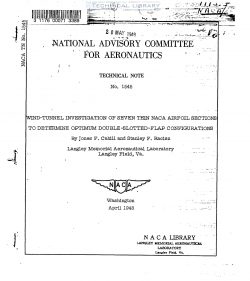naca-tn-1545
- Version
- 127 Downloads
- 1.65 MB File Size
- 1 File Count
- December 4, 2016 Create Date
- December 4, 2016 Last Updated
National Advisory Committee for Aeronautics, Technical Notes - Wind Tunnel Investigation of Seven Thin NACA Airfoil Sections to Determine Optimum Double Slotted Flap Configurations

The use of thin wing sections to increase the critical speeds of
high-speed, highly loaded airplanes has been accompanied by the need for
suitable high—lift devices to be used for take-off and landing. An
inrestigation was made in the Langley two—dimensional lowhturbulence
tunnels to determine high-lift trailing-edge flaps suitable for use on
thin wing sections that are most likely to be used on high—speed aircraft.
The first part of this investigation, reported in reference 1, covers
the tests of four types of flap for the NAGA 65—210 airfoil section. The
double slotted flan, discussed in reference 1, gave maximum lift coef—
ficients higher than any one of the three single slotted flaps tested.
The second part of this investigation, reported herein, covers the tests
of similar double-slotted—flap configurations for six other thin NACA
airfoil sections. Data from reference 1 on the NACA 65-210 airfoil
section with a double slotted flap are included to complete the comparison
of the results obtained.
The seven thin NACA airfoil sections tested with double slotted
flaps in the Langley two—dimensional low—turbulence tunnels are as
follows: NACA 63—30, 6L208, exp—210, 6h1—212, 65—210, 66-210, and 11:10
airfoil sections. Profiles of the plain airfoil sections are shown in
figure 1.
The ideal max lift configurations were determined at a Reynolds
number of 2.h x l for each of the double slotted flaps which consisted
of a 0.250—chord main flap and a 0.075-chord fore flap. The section
lift and pitching—moment characteristics were then measured at higher
Reynolds numbers up to 9.0 x 106 for configurations that not only approxi—
mated the ideal maximam lift configurations but that also allowed. the
flap and fore flap to retract as a unit within the airfoil contour. The
effects of leading-edge roughness on the section lift characteristics
were determined'st 'a Reynolds number of 6.0 X l.
| File | Action |
|---|---|
| naca-tn-1545 Wind Tunnel Investigation of Seven Thin NACA Airfoil Sections to Determine Optimum Double Slotted Flap Configurations.pdf | Download |
Comment On This Post